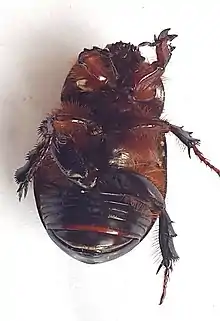Heteronychus arator
Heteronychus arator (hetero+onychus = 'variable claw', arator = 'ploughman') is a species of beetle in the subfamily Dynastinae (the rhinoceros beetles). It is commonly called African black beetle or black lawn beetle.[1] It is native to Africa and it is an introduced species in Australia, Norfolk Island and the North Island of New Zealand.[2]
| Heteronychus arator | |
|---|---|
 | |
 | |
| Scientific classification | |
| Domain: | Eukaryota |
| Kingdom: | Animalia |
| Phylum: | Arthropoda |
| Class: | Insecta |
| Order: | Coleoptera |
| Family: | Scarabaeidae |
| Genus: | Heteronychus |
| Species: | H. arator |
| Binomial name | |
| Heteronychus arator (Fabricius, 1775) | |
Morphology
It is a shiny black (or dark reddish brown) oval-shaped beetle 12-15 millimeters long. The head lacks a carina or tubercles, unlike some other scarabs. The clypeus is truncate with distinct lateral margins, and dentate with a denticle in the middle. Each mandible has 2-3 teeth on the outer edge and is visible when looking at the beetle from above. Each antenna is 10-segmented and ends in a 3-segmented club. On the underside of the head is a mentum with a rounded apex. Each eye is partially split by a glabrous (smooth) ocular canthus. The pronotum is smooth, convex and lacks punctures. The elytra have rows of shallow striae. The propygidium (dorsal plate of the second-last abdominal segment) has a pair of stridulatory bands. The hind legs have tibiae with truncate apices. All legs end in simple tarsal claws.[3]
Diet
Adults feed on stems of plants at or just below ground level, while larvae feed on organic matter and roots in soil.[1] This species may damage lawns and other turf, especially during the summer, as well as many crop plants, garden flowers,[4] trees and shrubs.[1] It prefers some plants over others: larvae gain more weight when feeding on ryegrass than on white clover or lotus.[5]
Diseases
This species is infected by a small RNA virus. This virus develops in the cytoplasm of gut and fat body cells. It can also infect larvae of greater wax moth (Galleria mellonella) and some other insects, but cannot infect mice.[6]
References
- African black beetle (Heteronychus arator) - pest of viticulture. Archived 2011-03-20 at the Wayback Machine Western Australia Department of Agriculture. 2005.
- "Heteronychus arator (African black beetle)". CABI Compendium. 2022. doi:10.1079/cabicompendium.27067. S2CID 253615399. Retrieved 2022-12-16.
- "Heteronychus arator". keys.lucidcentral.org. Retrieved 2022-12-16.
- African Black Beetle - Heteronychus arator. iLandscape.com.au, April 3, 2012.
- King, P. D. (1977). "Effect of plant species and organic matter on feeding behaviour and weight gain of larval black beetle, Heteronychus arator (Coleoptera: Sacrabaeidae)". New Zealand Journal of Zoology. 4 (4): 445–448. doi:10.1080/03014223.1977.9517968. ISSN 0301-4223.
- Longworth, J. F.; Carey, G. P. (1976-10-01). "A Small RNA Virus with a Divided Genome from Heteronychus arator (F.) [Coleoptera: Scarabaeidae]". Journal of General Virology. 33 (1): 31–40. doi:10.1099/0022-1317-33-1-31. ISSN 0022-1317. PMID 978185.
Further reading
 Media related to Heteronychus arator at Wikimedia Commons
Media related to Heteronychus arator at Wikimedia Commons Data related to Heteronychus arator at Wikispecies
Data related to Heteronychus arator at Wikispecies